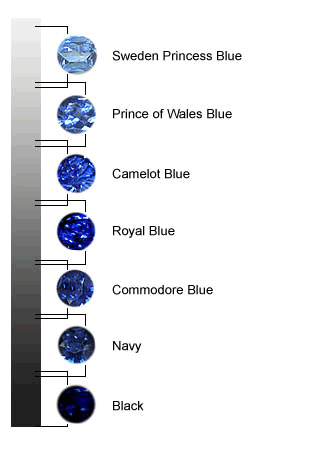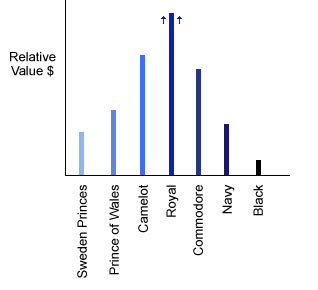How to Buy a Blue Sapphire
In our opinion, the sapphires offered at most jewelers are simply too dark – inky blue bordering on black. Often to see the blue in these sapphires you’d need to stand under intense direct light.
In our society “more” is often associated with better. When it comes to gemstones, more color does not necessarily equate to a better, more desirable gem.
In its finest qualities, a blue sapphire should be blue under normal life lighting conditions – home, office, and outdoors; not just under the bright showcase lights of a jewelry store.
Cross’ Passion for Blue Sapphire
People often comment on how blue our sapphires are, how brilliant and pure the color. We believe in blue, pure true blue. We search the world over for the best bluest sapphires…looking through hundreds, sometimes thousands of sapphires to choose just one.
Chosen One at a Time
Most jewelers prefer dark sapphires because they are easier to source and easier to match. Our sapphire jewelry starts with the selection of the individual gem. We choose gems one at a time, and evaluate them under different lighting conditions to find the best performing sapphires.
The result is a gem which is bright, blue, and brilliant – everything you want in a sapphire. This process takes more time and it results in the best, brightest, and truest bluest sapphire jewelry. The jewelry is then specially crafted to fit the gem.
Blue Sapphire Color
Blue is a color beloved by many. Our passion for blue has resulted in a sapphire collection that spans a wide range of blue tones, from our light pastel Sweden Princess blues to the rich and velvety Royal Blue sapphires. Whatever your favorite blue, we have the shade you will love.

Above is a tone scale for degrees of lightness & darkness. Rather than absolute starting and stopping points, the color groups overlap and can blend into one another.
We select loose sapphires individually and build a piece of jewelry around the gem. We choose sapphires that range in tone from Sweden Princess blue to Commodore blue.
The shade of navy to many people appears too dark. Our simple test is to hold a sapphire at arms length under normal lighting conditions. If it’s difficult to see the blue then it’s too dark. (these darker gems are very common in many stores)
The Cut of a Sapphire
After color, cutting is the most important factor in a colored gem. When discussing cut, we are not talking about shape (round, oval, etc.), but rather the proportions and angles of a gems facets.
Precision cutting brings a sapphire to life. A Royal Blue sapphire poorly cut could be far less valuable than a Prince of Wales sapphire with an excellent cut. We take great care when selecting sapphires because cutting is important. Our cut grade is determined by the brightness and evenness of the gems brilliance. Our cut scale goes from 1 to 10, with 1 being excellent and 10 representing poorly cut gems.
A Royal Blue Sapphire with a cut grade of 1 would indicate the gem to be a wonderful medium to medium dark blue with extraordinary brilliance that’s evenly distributed throughout the sapphire. Cross only selects sapphires that 1-4 on the cut scale.
Price and Value

Most jewelers prefer dark sapphires because they are easier to source and easier to match. Our sapphire jewelry starts with the selection of the individual gem. We choose gems one at a time, and evaluate them under different lighting conditions to find the best performing sapphires.
The result is a gem which is bright, blue, and brilliant – everything you want in a sapphire. This process takes more time and it results in the best, brightest, and truest bluest sapphire jewelry. The jewelry is then specially crafted to fit the gem.
Sapphire Hardness
Sapphire is the second hardest gem after diamond and has long been a popular alternative choice for engagement rings. It’s ideally suited for every day wear.


